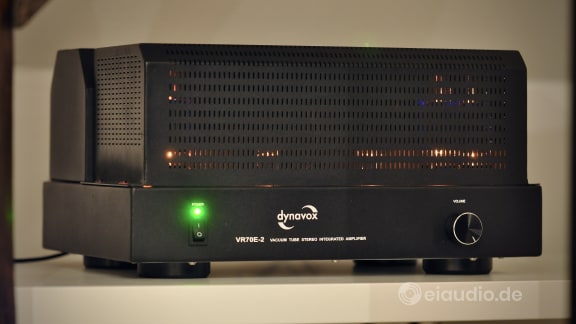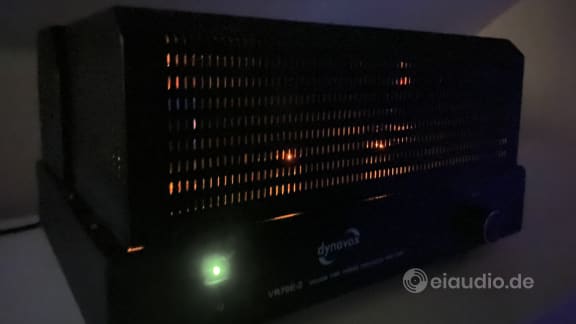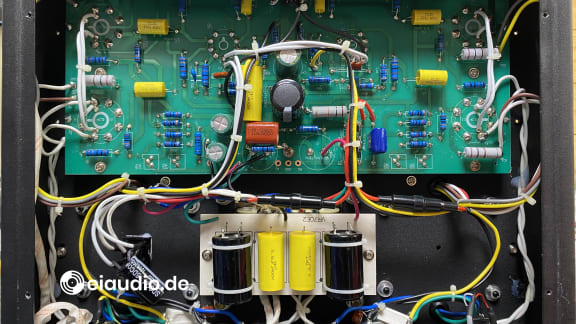Dynavox VR-70E II (Part 2)
Published: 26/05/2022
Author: Karsten Hein
Category: Explorations
Tag(s): Power Amplifiers
When I wrote my first review of the affordable Chinese import tube amplifier back in January 2022, I promised that I would write an update on my impression of the VR-70E II after it was returned to me following some modifications. My reason for having the amplifier revised had been the level of humming, its lack in audiophile frequency extension, as well as poor transients and imaging, which altogether resulted in a certain blandness of sound. My original tests had been conducted with our Dynaco PAS-4 tube preamplifier and the formidable 8 Ohms Tannoy XT-8f tower speakers.
Upon my handing in the amp, the tube specialist had offered a speedy service within a couple of weeks, to which I had agreed. Then, however, he had somehow gotten caught up in other projects and seemed to have forgotten about me. When he then started to ignore my phone calls—after five months of patience on my side—I decided that enough time had been wasted and picked the VR-70E II up in close-to-original condition. I think we were both surprised and sad that I should have taken such resolute measures, but it seems that I had simply run out of patience with him. On my drive home, with the amp in the back of our car, I was wondering what could be done next: Sell it? Keep it for a later project?—I would need to listen to it one more time to make my final decision.
Now, I am not sure if you sometimes have a sonic memory of the things that you have listened to. We commonly have this gift when it comes to scents or smells. As we often connect scents with emotions, we tend to remember them for a long time. This is especially true for the early experiences in our lives, and we might remember the smell of our kindergarten, or school, or perhaps of the house of your grandparents. Well, it seems that some people have a sonic memory.
For instance, I vividly remember the sound signature of my first CD player. This was a 1988 JVC XL-Z444, and I recently even purchased this unit again, just to enjoy the sound one more time. This was not an audiophile CD player by any means and it does not need to be discussed in this blog, but its stoic crudeness and pitch-black backdrop certainly had its charm and served to set it apart from vinyl records, cassettes, and radio broadcasts at the time. I really celebrated listening to it again and having my juvenile memories confirmed. In a similar way, I still held a sonic memory of VR-70, and I was a little bit frightened of having this revived the second time around.
With five months having passed since my original test, the set-up environment of our smaller system had meanwhile changed. The Dynaco tube design had given way to our Restek V1 solid state preamplifier. The speakers, too, had been replaced. Instead of the Tannoys, a pair of Epicure EPI 500 had found its way into the lineup and had just been optimised in terms of coupling towards the hardwood floor. In the meantime, I had learnt from trying to match the Dynaco with our B&K ST-140 amplifier that this preamp could easily have a lowpass effect in some set-up combinations. In my first test, I had all too hastily attributed the experienced loss in top-end to the Dynavox amp. This had happened, because I had been as yet unaware of the PAS-4’s shortcomings in terms of compatibility.
Hence, when I sat down to listen to the VR-70 E II this time around, the treble was more open and spacious with improved transients right from the start. I was also happy to find that the original tube-hissing that I had heard from the amp had disappeared. The reason for this was twofold: first, the Restek V1 was a dead-silent preamp to begin with, whereas the PAS-4 produced a mild tube hissing on its own; second, the technician had found a grounding problem with the VR-70 itself. He saw that the properties of its pharadeic cage had been compromised by the bottom plate being paint-coated. He had consequently removed the paint to include the floor plate with the chassis grounding scheme. This had a significant effect on the VR-70's noise floor, which was now hardly audible, even with the ear held near the tweeter.
The original lowpass effect in combination with the Dynaco had also made me overly hasty in turning the amp in for service—after just 40 hours of listening. Since then, the technician had adjusted the amp’s bias to 350 mV and allowed it to run for a few more hours. This, too, had given the factory-new amplifier some time to homogenise its frequency response (break-in time) and helped to take some of the initial harshness off the critical vocal section. With the top-end having opened up and the bottom end having gained power due to reduced grounding noise, there was now more depth and dimension to the music in many ways. In direct contrast to the B&K ST-140 solid state amp, which had performed to our satisfaction in this position before, the VR-70 E II presented a considerably larger stage with very similar tonality.
Vocals seemed grainier on the Dynavox, an impression that did not lessen even when the tubes were at full operating temperature. At the same time, voices seemed slightly more distant on some recordings. I especially noted this effect on Tony Bennett & Diana Krall’s album “Love is here to stay”. This may have been intrinsic to the Chinese tubes that had surely not been chosen for their superior tonal characteristics but rather for their bang-for-buck regarding their use on an entry-level amp. At the Dynavox’s current quality of output, I was fine with the idea of having to upgrade the tubes in some not-too-distant future in order to fulfil the promise of audiophile bliss.
From my original four complaints about the amp: bland top-end, tube hissing, poor imaging, and grainy voices, only the last point remained. And this—surprisingly—despite all original parts still being present. I felt a little silly for not having tried matching a different preamplifier in the first place, but then again, I probably would not have learnt about the chassis grounding issue on my own. The experience only shows why it is so important that this page is called “Explorations in Audio” and not 'Facts' or 'Truths' in Audio. Life means ever learning, and only the mindset of the Explorer can expect and appreciate the surprises that the journey brings. To prove the point, and also to treat myself to today’s Father’s Day present from my wife, I will stop writing and focus my attention on the 1970s album “New Skin For The Old Ceremony” by Leonard Coen on vinyl.
Back to Part 1 | [to be continued with new tubes…]
Specifications
- Power output (RMS, 8 ohms): 2 x 40 watts
- Input impedance: 20 kOhm
- Pre-amplifier tubes: 2 x 6F2 (ECF82)
- Power amplifier tubes: 4 x EL34 (ultra-linear)
- Tube bias: 300 - 350 mV
- Frequency response: 10 - 40,000 Hz
- Total harmonic distortion: 0,1%
- Signal to noise ratio: >88 dB
- Damping factor: N.N.
- Output terminals: 4/8 Ohm, gold plated, for spades or bananas
- Dimensions: (W) 35,0 cm x (D) 30,0 cm x (H) 18,5 cm
- Weight: 14,5 Kg
- Year: 2013 - 2022





